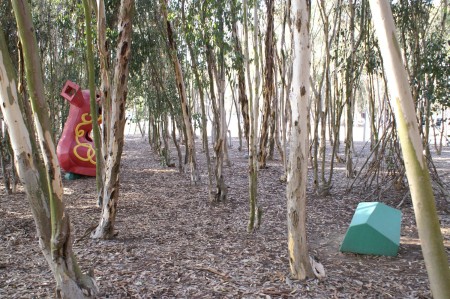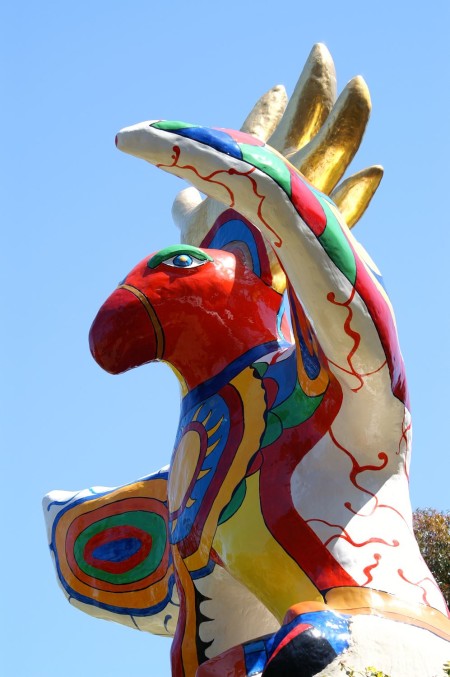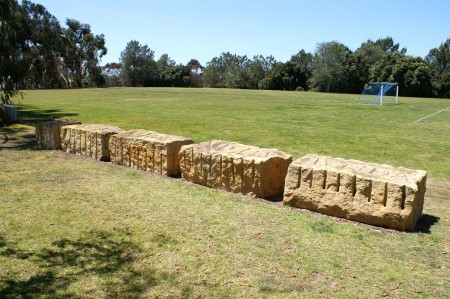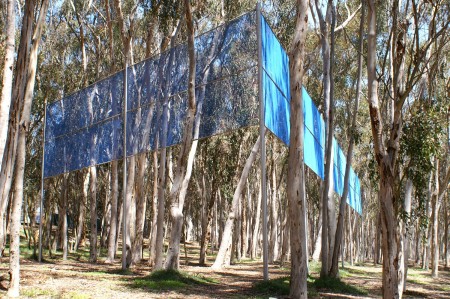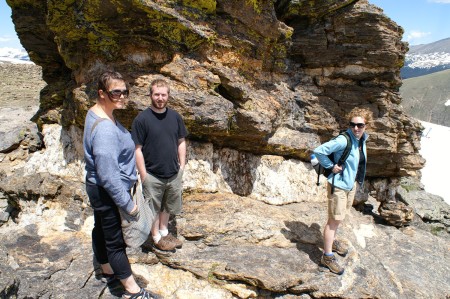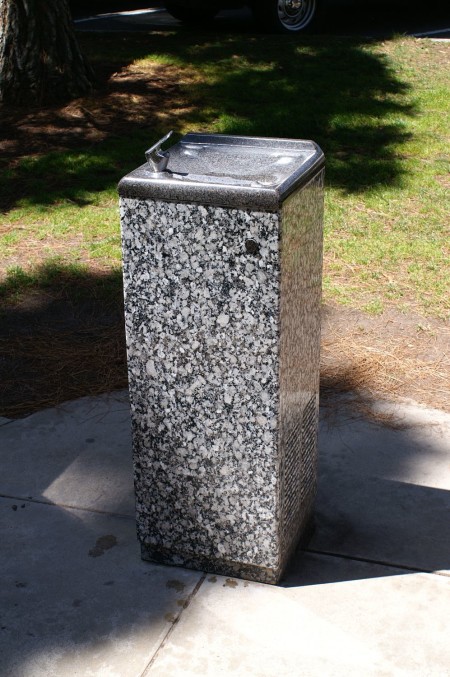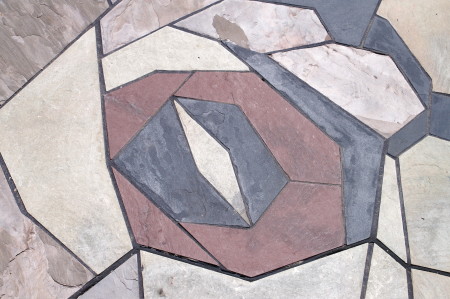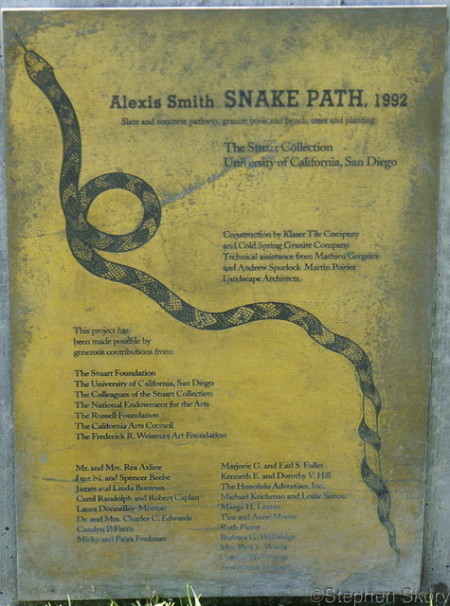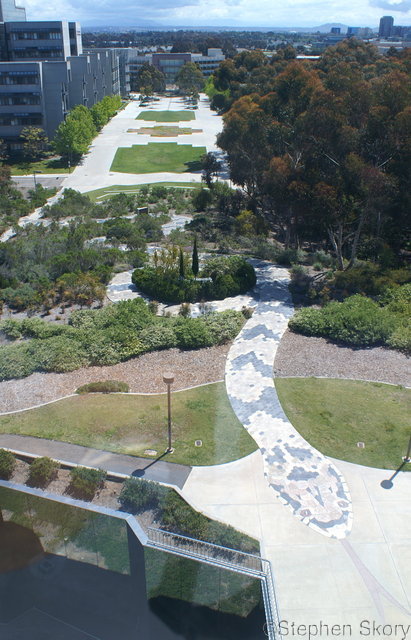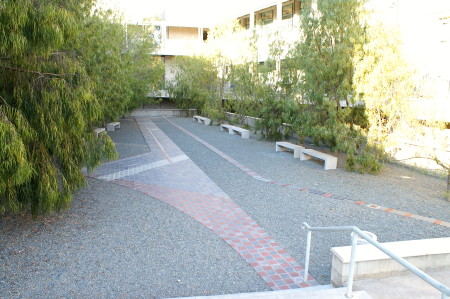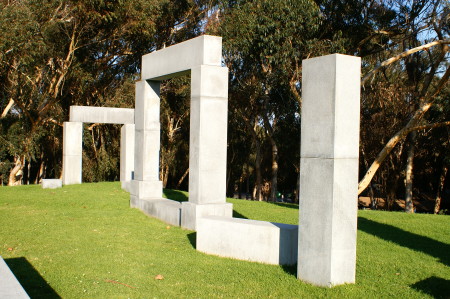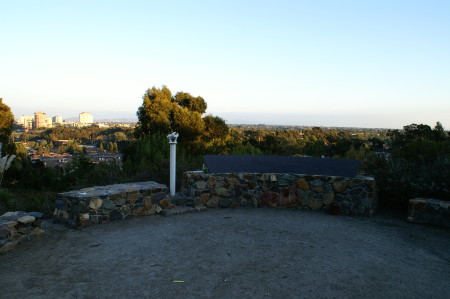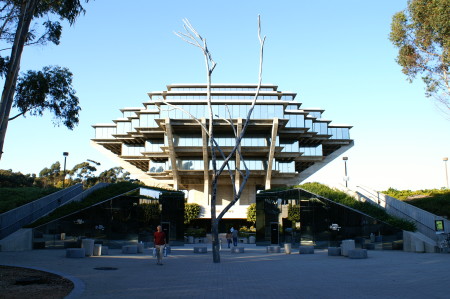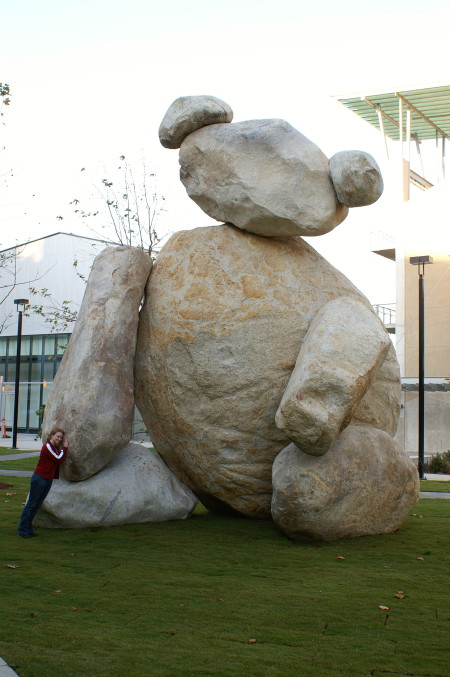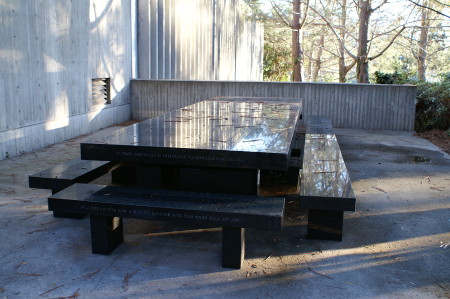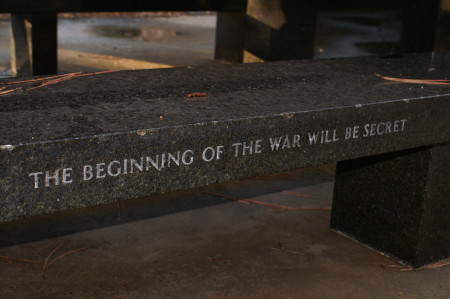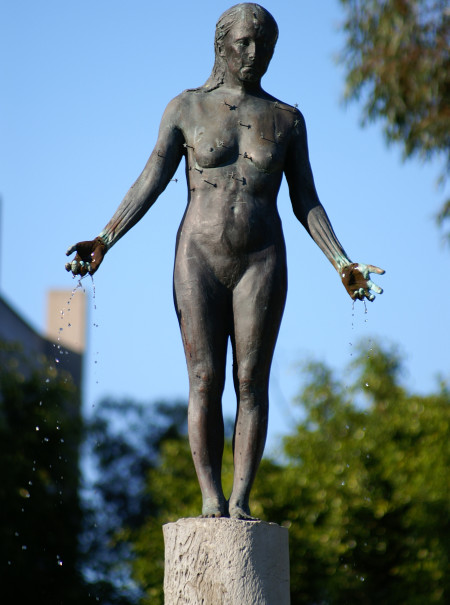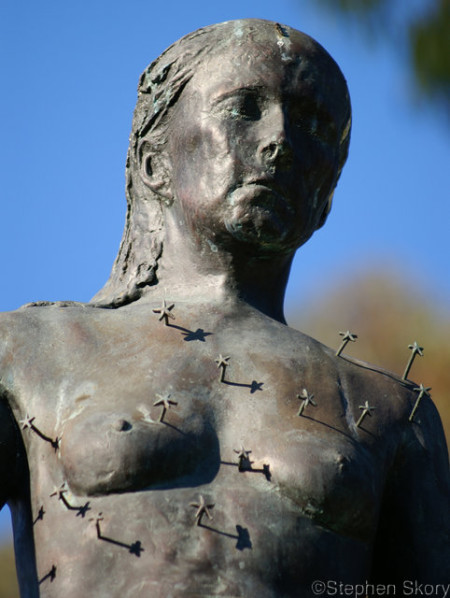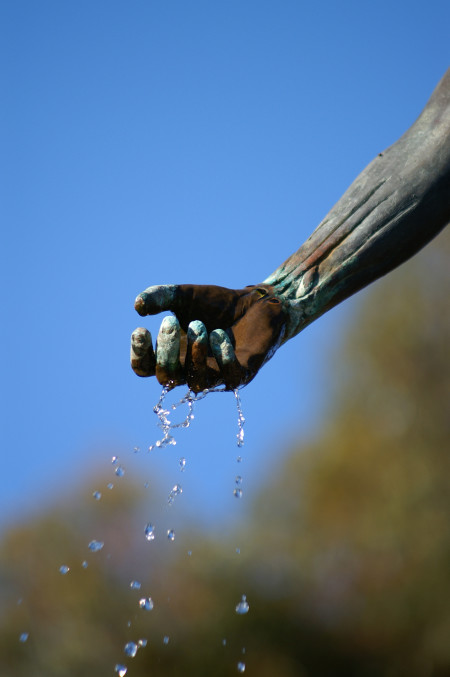Red Shoe – 1996
Red Shoe, by Elizabeth Murray, is situated near La Jolla Vista View in the far South corner of campus. This is probably the least-visited of all the Stuart Collection items. Not only is this item blocked by two large parking lots from the active part of campus, it is buried in a grove of Eucalyptus trees. It is one of my last Stuart Collection items for this reason.
It is made up of cedar and paint using a technique similar to boats. It is open so one can look inside and see its simple construction. The heel is high in the air indicating that the person wearing this shoe would be taking very long steps, and this would be the trailing foot. There is a yellow shoelace tangled on the side, but there is only one eyelet. There are odd, angular rocks littered near the shoe which, frankly, I don't understand.
I have strong feelings about this piece. I don't like the randomness of it (rocks?) because it's half-hearted. If you're going to be random, you should go all the way. Here, Murray has mixed children's fables with Dahli-like solid object manipulation. It's just not well done in my opinion.
more ...Sun God – 1983
Every year in May UCSD hosts the Sun God Festival, which for most students is an excuse to get drunk and skip class. It is held on the lawn surrounding the Sun God, a large bird-like statue in the middle of campus. There are many student organizations that set up tables & other activities, such as inflatable sumo wrestling or pixie bike jumping. Usually, the controversial student publication, The Koala, has some kind of water-based activity. One year ago it was a slip-n-slide, and this year it was a slip-n-side too, but this time with a chute off a small embankment.
All of this, I suppose, is in tribute to, or because of the statue for which the festival is named. After all, the artist who made it was French, until 2002, when she died.
What's not to like about this entry in the Stuart Collection? It was the first item in the collection. It's colorful, simple, vibrant, and not hard to interpret. Perhaps out of all the items in the collection, this is the one UCSD students actually pay attention to most. And that's saying something, if you've ever met an UCSD undergraduate.
more ...UNDA – 1987
UNDA, by Ian Hamilton Finlay (1987) is in the vein of the La Jolla Project, another Stuart Collection item. This time, the stone blocks are smaller and fewer in number. These stones are English limestone and have the latin word for "wave" carved into them, unda. To be more precise, the letters are carved out of order with a s-like shape included which transposes the letters to put them back in order to spell unda. According to the official page on this item (linked above) the wave moves through the letters like the waves in the nearby ocean, making a literary "wave" or something.
It seems to me that since the La Jolla Project had been installed three years before this item, putting plain blocks out on a lawn would have been plagiarism. Finlay probably thought to himself, "I've got all these bloody blocks of limestone, but some other bloke already did art with stone blocks. Let's put some latin on them -- and perhaps put it in the wrong order, like the word has been hit by a wave. No! Wait! I've got it!" And the result is what we see today.
This entry in the Stuart Collection is a good one, not a great one nor a poor one. I'm always skeptical of art that I feel is forced (waves upon waves upon undas, bah!) but this is okay despite that. The stone has a nice texture which I'm sure changes by the year due to weathering. The stones were cut roughly so they aren't square and perfect like the La Jolla Project. The stone has character which the unda doesn't ruin. It's worth your time to see.
more ...Two Running Violet V Forms
In my opinion, Two Running Violet V Forms by Robert Irwin (1983), is the most easily describable entry in the Stuart Collection. Put simply, it is blue chain link fence raised thirty feet off the ground, arranged in two V shapes, set in the eucalyptus grove in the middle of campus. There's really not much more to say about it.
Um, wait it also has -- nope, um -- uh, yeah. That's really all there is to this art.
Really.
Oh, okay, I do have something to say about this "art." A couple things. First, this is another entry in the list of Stuart Collection art I could have done myself. That's not a good thing. Second, at least this art is easily avoidable, being in a part of campus I rarely go. If I do go there, I just have to keep my eyes low and I go right through it unmolested. Save your time and see something else while on campus. Third, while describing it is easy, understanding it isn't. Do you understand it? If so, can you help a brother out?
I promise that upcoming Stuart Collection posts will be more interesting!
more ...Something Pacific
I managed to go by Something Pacific (by Nam June Paik in 1986) numerous times before I ever noticed it. In fact, the first time I expressly looked for it, I couldn't find it. Its entirety is a few foot-high statues watching concrete-filled 1950s televisions, placed in on a lawn. It is a fairly unimpressive work, considering that the artist was a video artist. The televisions don't function. Anyone can put televisions out on a lawn. I'm serious about this. A video artist is worthy due to what s/he has the televisions show. Using the standards of this work, I could be a paint artist by putting empty cans of paint out in the middle of a lawn. See! Paint cans! On a lawn! I'm a painter!
Perhaps the only redeeming quality of this art is that you actually have to slow down to notice it. Overall, this is a sub-par entry in the Stuart Collection, in my opinion.
(p.s. If you go to the official page for this item you'll see that in the lobby of the Media Center there are some functional televisions. This doesn't excuse the lameness of the outdoor part.)
more ...Untitled
This is the most useful of all the Stuart Collection items. Yes, it's just a drinking fountain. Actually, it's a refrigerated drinking fountain, and it's by Michael Asher, done in 1991. The fountain is made of two kinds of granite, and looks exactly like the fountain you'd find in many buildings. I guess there's supposed to be some kind of symbolism in this, with grass surrounding the fountain, & the history of the site as an Army shooting range. However, it feels kind of stretched in my opinion. The irony here isn't very strong. In the end, it's just a drinking fountain, one that's perhaps more interesting than most.
more ...Snake Path
Continuing my Stuart Collection, err, collection, I've posted photos of Snake Path (1992) by Alexis Smith. Snake Path is located on a hillside just east of Giesel Library. It's made up of hundreds of shaped pieces of various kinds of stone.
The snake loops over itself and inside the loop there is a bench with a quote from Milton's Paradise Lost. The biblical touches nonwithstanding, I like the path. It begs you to walk its full length like a British garden maze. The path has a definite central crown, like a road, which emphasizes that a real snake is three dimensional. It makes the walk down the hill slighty precarious, making the walk a bit more like an adventure.
more ...Terrace
There are only two items from the Stuart Collection located in the UCSD School of Medicine, one of which I've already profiled. The other is Terrace by Jackie Ferrara (1991). At first glance, this might seem to be a courtyard, but I think courtyards have many entrances to it, and this has only one side open. Is it a patio or a terrace, then? When I think of a terrace, it's high above things, perhaps on the top of a tall building in New York City. This is more of a patio -- there are buildings surrounding it on all but one side. Perhaps when it was built 15 years ago there were fewer buildings around it; it is no longer a terrace in my opinion. It's hard to take photos of it now because the trees have grown large and wide. I suggest looking at the official site for photos when the trees were much smaller.
I have to admit I don't particularly like this item, or at least its location. It's off in a corner of the medical school that few people ever go. When I visited it I realized that I had walked by it a few times without even noticing it was there. It would have been better if this had been built where more people would notice it and use it. Since it does have benches and shade trees, it's meant to be used, and somehow I get the feeling that it is underused.
I do like the geometries of the bricks, and it looks like it would be a nice place to eat a lunch on a sunny day. Perhaps I should go visit it during some lunchtime and see whether or not it is being used by the medicine folks.
more ...La Jolla Project
Often called "Stonehenge," for obvious reasons, perhaps the heaviest item in the Stuart collection is La Jolla Project by Richard Fleischner, installed in 1984. It is a grouping of solid granite columns and beams which form mostly asymmetric shapes over a Revelle college lawn. Most of the parts are centered in one area, but a few are scattered over the entire lawn. Most of the shapes are tall, but there are some squat pieces, probably meant to be sat upon. Some granite pieces are laid to suggest decay, littered below tall, naked columns.
To me this art speaks about time. The granite was cut very recently (geologically) by a machine, so the cuts are very clean. However, parts have been arranged like they were broken to suggest the passage of time. But these fallen pieces still have sharp, clean corners that don't look old at all. La Jolla Project reminds me of Stonehenge, which was built based on the celestial calendar. This one should last longer than any other Stuart collection item.
more ...La Jolla Vista View
The theater (or is it theatre?) arts part of campus is on the southern tip of campus, which overlooks La Jolla, University Town(e?) Center, and farther into Kearny and Clairemont Mesa. Situated here is La Jolla Vista View (1988) by William Wegman. Follow eitehr link and you'll learn he's best known for his photographs of posed weimaraners.
As far as I know there are no weimaraners etched into La Jolla Vista View, but there might be. The large bronze plaque is situated to match the vista in front of you, with mountains and communites named so you can find them in the distance, much like something you would find in a national park. However, the labelling is unorthodox, and that's where this becomes art. "Barren Wasteland," "A Big Development," and "La Jolla Gateway to Hell" are some of the named sites. There are also buildings & business, which are much less permanent than the mountains and communities also named on the plaque. Much has already changed in the two decades since Wegman designed the plaque.
My opinion of San Diego and urban sprawl closely matches the tenor of La Jolla Vista View. I like the small touches, like a tree with "Meow, Meow" coming out of it. The telescope even works for free! Since this piece of art is hard to find and in a far corner of campus, it is perhaps one of the least visited. I encourage you to check it out, it's well worth it, and you'll learn some real & humorous San Diego geography (which are not mutually exclusive) in the process.
more ...Trees
One of the most photographed member of the Stuart Collection is the lead-enacased tree in front of the main library on campus. There are two other trees part of the installation which are hidden inside of a eucalyptus grove southwest of this tree. Together, they are part of the Trees by Terry Allen which were installed in 1986. Apparently the trees encased in lead were salvaged by the artist from a group of eucalyptus trees that were cut down for a new building on campus. The two trees that I didn't take pictures of play music and speak poetry. But that would be hard to photograph, wouldn't it?
This is an excellent kind of art in my opinion. It's not too dense and obscure but isn't too simple. The tree forces the viewer to look up from a distance to take in the whole thing. Up close there are other things to see, too. Of course all the Stuart collection items are meant to be touched, but this one perhaps more than others. The soft lead is very easy to make an impression upon, giving everyone input to the art.
more ...Bear
The most recent addition to the Stuart Collection is Bear (2005) by Tim Hawkinson. The bear is made up of 8 large boulders weighing 180 tons altogether. It sits in a courtyard in the engineering school with several new and highly angular buildings. If you read the description in the link above the artist was fully aware of the contradiction of a stone teddy bear between high tech buildings.
I very much like this part of the collection. I've been eagerly awaiting it's completion since I heard about it. I always like it when art requires a massive effort, and moving a 100 ton boulder (which is what the body stone weighs) is massive. The bear does seem cuddly, like you could pick it up and take a nap with it. But of course you can't. I also like bigger than life art, which is a fairly popular category in cities around the world.
more ...Green Table
Green Table by Jenny Holzer (1992) is a large rectangular table with dozens of "truisms" etched into the granite. I like this peice of art because it's something I think I could do.
I like that not only can you use the table as you would any other, you can perhaps gain some small nuggets of wisdom. However, some of the truisms are sexist towards men, and others just plain wrong, in my opinion. But I guess that's the point -- these are not truisms. Some are common sense, others are simply cleverly-worded opinion. Truisms on the table contradict other truisms. Read the list linked above and see for yourself.
more ...Standing
UCSD is home to a very unique art collection, the Stuart Collection. As of November, 2005 there are sixteen items in the collection scattered over the entire campus. As a way to practice using my new camera I'll be taking photos of all the items and posting them on this website.
My first posting is of Standing by Kiki Smith (1998). Personally, I think it's a disturbing statue/fountain. The water running from her hands and the nails sticking out of her body aren't a pleasant thing. Although the starfish nails are supposedly placed in the shape of the constellation Virgo, it's hard to tell when you're looking up at it. Also, the hands have rusted a dark red color, something like dried blood.
more ...